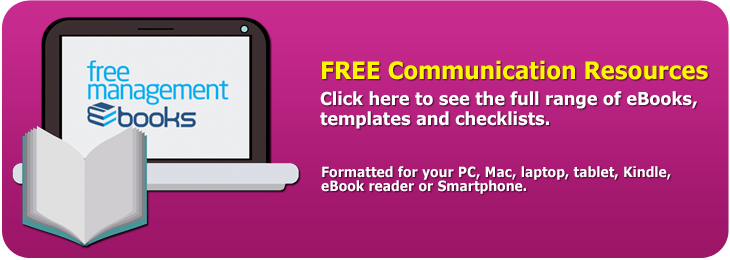Communication Skills - Four-Stage Presentation Planning Process
The amount of effort you put into planning your presentation will depend on how much impact it needs to have and how much time you can justify. In the case of a sales presentation that you are going to give regularly, this could amount to several days. Similarly, if the presentation is important to your career then you should spend as much time as you have available.
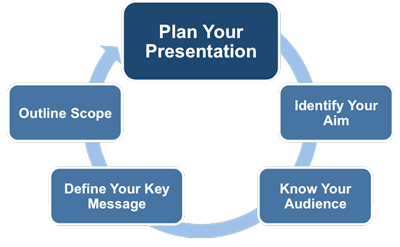 |
Irrespective of how much time you have, the best approach to planning is to use a method that will give you a usable structure as quickly and efficiently as possible. You can always refine it later if necessary. There are four key stages to planning your presentation:
1. Identify your aim
2. Know your audience
3. Define your key message statement
4. Outline the scope. Identify Your Aim
The first stage of the planning process is to decide on the precise aim of your presentation. This should be in the form of a goal that summarizes what it is that you personally want to achieve from delivering it.
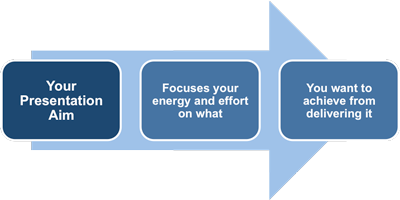 |
Your aim is not the 'title' of the presentation and it is not something that you want your audience to see. Its purpose is to concentrate your own mind on exactly what it is you are trying to achieve.
If you think of your presentation in terms of a journey then your aim describes the final destination that you want to take the audience to from wherever they are at the moment. Even in low-key presentations, where the primary objective is to inform the audience, there is usually a secondary objective, which is at least as important because it supports your own goals. For example:
Scenario 1
• You are giving a monthly progress report to your own team:
• Its primary objective is to keep the team up to date with progress.
• Your secondary objective may be to find out if there are any group concerns that you need to address in order to preempt problems or boost team morale.
Scenario 2
• You are giving a presentation to other managers in your own organization:
• Your primary objective is to inform them about some changes that you are making that will affect them.
• Your secondary objective is to answer any concerns that they may raise, and to get them onside and enthusiastic about implementing those changes.
In both of these examples the secondary objective is the one that provides the justification for presenting the information rather than simply sending it out as an email or document. It is also the one more closely aligned to your own personal goals.
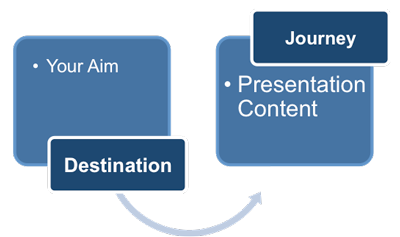 |
From the outset you must be absolutely clear on the aim of your presentation so that you stay focused throughout the preparation phase. The following table gives you some examples of the different aims you could have for three different types of presentations you may need to give.
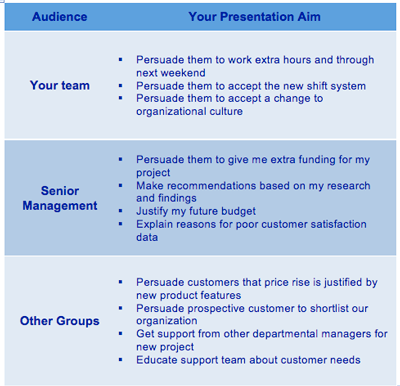 |
All of these example presentation aims are written from your own point of view. In the case of presentations to your own team, the aim will be something that you have decided on from the outset. In the case of presentations to senior management, you will usually have been asked to make the presentation and your aim may be rather less obvious.
For instance, you have been asked to present the figures on the budget you have requested for next year. You may decide that your real aim is to justify these figures and prevent them from being reduced. Changing your aim from the obvious...
'Inform the board of my budget requirements for next year'
to the more precise
'Justify to the board my budget requirements for next year'
is a subtle change in wording, but makes a significant difference to how you decide to structure your presentation because it explicitly changes the focus from simply reporting the figures to gaining a commitment to accept them. Using the word 'justify' will focus your mind on defending the parts of your budget that you see as vulnerable, for example by showing how they fit into your organization's strategic plans.
Another example would be a situation where you have been asked to present the results of a customer satisfaction survey in which the organization has performed poorly. Changing your aim from...
'Inform the board of results of customer satisfaction survey'
to
'Explain reasons for poor customer satisfaction data and suggest options to fix the problems'
will keep you focused on the most important aspect of the material you are going to present: in this case, suggesting options to fix the problems that have been identified. If you just presented the survey results without this focus, it could look as though you didn't understand the implications of the survey, you didn't think any action was necessary, or you had no ideas about how the problems could be addressed.
Changing the focus of your presentation from just reporting the results demonstrates that you have already grasped the negative implications, have identified the main reasons for this perception, and are able to suggest possible solutions.
Remember, think of your aim as a final destination, and your presentation as the journey to it. Everything in your presentation must contribute to delivering your audience to that clearly defined destination.
The aim is to some extent dependent on your audience, which is not a problem when you are presenting to your own team or senior management because they are familiar to you and you will usually have a clear idea of what the 'starting point' of the journey is. In other words, you know what they already know and what is important to them. Knowing these things makes it relatively straightforward to work out what you need to tell them to take them to the destination. However, when you are presenting to the 'other groups' category, you may need to spend some time thinking about the make up of the audience before you can make this judgment.
You may also be interested in:
Planning a Management Presentation | Everyday Management Presentations | Advantages and Disadvantages of Presentations | Audience Profiling | Presentation Environment | Define Your Key Message Statement | Outline the Scope of Your Presentation | Management Presentation Planning Guidelines.


